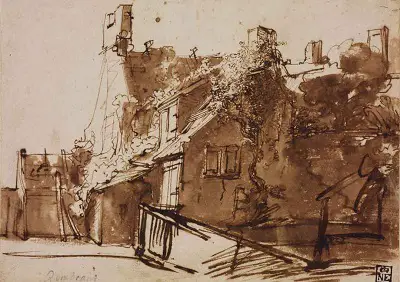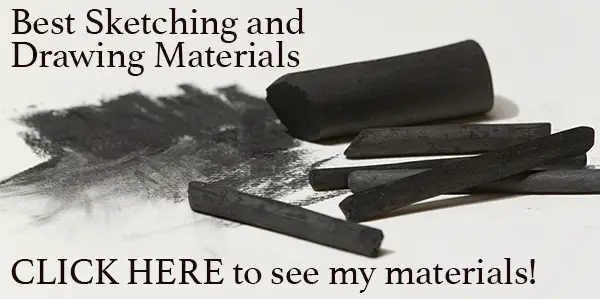
Getting Good at Sketching-How Long Does It Take?
Getting good at sketching or drawing requires dedication, determination, and inspiration, but it's also something that can be done by anyone. Let's take a closer look at how long this process can take and what it takes.
You can get good at sketching or drawing by committing to doing 5 sketches a day, or for drawing at least a half-hour a day for 5 years. This is best accomplished if you draw from life, and learn the principles of drawing such as perspective, proportions, composition, and anatomy.
Of course there are many variables to the above statement which we will discuss below.
10,000 Hours or 20 Hours?
Some say it takes 10,000 hours to master something, others say it only takes 20 hours to learn something. A distinction should be made between the terms learn and master. I learned how to ride a bicycle pretty quickly once the training wheels were off, and while I can still ride a bike, I would not call myself a master bicyclist. That term seems better applied to those young kids who can do all those jumps and flips without breaking bones.
In the medieval craft guilds, one would be an apprentice for about seven years before being declared a journeyman. Only after creating something deemed a masterpiece by the guild masters could a journeyman be considered a master. While we don't have such guilds today, learning to draw and mastering drawing requires similar dedication.
The Ability to Draw Versus Mastering Drawing
Learning to draw is basically being able to create a faithful representation of what you see or intend, utilizing some type of instrument that can make makes on a surface that can receive those marks. If you can look at something, or imagine something and replicate it correctly, or even somewhat correctly on paper, you have the ability to draw.
Mastering drawing is different. A master can not only faithfully replicate something in front of them or in his/her imagination, but they can also communicate something beyond just mere physical appearances, whether it's transporting the viewer to a moment or location, or capturing the emotion in a child's face. This can take many years or even a lifetime to accomplish.

The Good News and the Bad News About Getting Good at Drawing
If you commit to drawing every day, learning as much as you can about it, and putting that into practice, you will get better and you will learn how to draw, no matter what your current skill level. I used to draw ducks that had necks like giraffes. I was tight and tense, and my pencil would run off the page more times than I'd like to admit. But eventually, I got better, and you will too.
The bad news is that masters are rarely if ever satisfied with their work. I have read many interviews with artists I admire and consider the top in their field, and they pretty much all admit they wish they could draw or paint better. From personal experience, the only way I know I've improved is by not being as horrified by my current work as I am by my past work. But this mentality keeps us moving forward.
See the types of pencils, charcoal, and paper I use on the Drawing and Sketching Resources Page.
Doing Five Sketches a Day for Five Years
Claire Walker Leslie, in her book The Art of Field Sketching, described how when master wildlife artist Maynard Reece was a young man, he was advised by Ding Darling to do five sketches a day for five years in order to become an artist. I took this advice to heart when I started doing art again, and it helped tremendously. At times I had to revise it to sketching one thing for a half-hour, due to a hectic schedule, but either way, it kept me going.
I also supplemented the above practice with the fairly rigid and very fruitful routine laid out in Kimon Nicolaides book, The Natural Way to Draw. This jump-started me and helped me know what to look for when I sketched something.

Enjoy The Journey of Drawing
We have all heard the saying, "It's a journey, not a destination." This is very true when it comes to being an artist. Becoming a good artist is not the same thing as becoming the CEO of a company. There never comes a point when you say, "I've finally become good enough." You will have successes, and even times, when the "good enough" temptation will whisper in your ear until someone else's great work of art knocks you back into reality.
Learn to enjoy the process of learning, because becoming better will never end unless you stop drawing.
I once heard it said that you must make at least 10,000 mistakes before you become a good artist. So I resolved to get those mistakes made as soon as possible. I don't know if I've made 10,000 yet (hopefully I have), but I've come to the understanding that I will always make mistakes, everyone does.
But My Drawing Isn't Getting Any Better
If you are not seeing any improvement in your drawing or sketching there are several things you will want to consider.
Challenge Yourself
Some subjects are easier to draw than others, and some people will be better at drawing certain things than others. An apple is easier to draw than a human face. If you have been drawing only apples, then you cannot expect to see much improvement.
Challenge yourself by sketching something you are unfamiliar with, or that you find difficult. For example, if you have been sketching facial profiles, switch to the front, or the whole human figure. If you sketch mostly nature, head into town and do some sketching.
Get Inspired
I cover this topic in more detail in my article Sketchbook Ideas: 10 Great Ideas To Maintain Your Artistic Inspiration.
Take a Break
Sometimes it may not be a lack of improvement, but a lack of objectivity. We can be our own worst critic, and if we look at something long enough, we will find something wrong with it or just get down on ourselves and fail to see our improvements.
Consider taking a break for a day or two. Before you start up again, take out your first sketches or drawing and look at them. You will most likely see that improvement has been made.
Get Educated
There is only so much we can accomplish on our own. While some artists are self-taught, no one is ever purely self-taught. I never went to school for fine art, but I benefited tremendously from several workshops I took, along with the books I've read and just hanging out with other artists.
If you have a local art association, sign up for a class. You can also buy some books and even check out YouTube (here I must make a shameless plug for my YouTube channel.) But keep in mind there are many resources out there to fit any budget and it's never too late to start.

Maintaining a Balance
As said above, you must learn to enjoy the journey. That journey should be a combination of motivation, dedication, inspiration, and education.
If, in the beginning, you only draw what inspires you, you may delay your improvement and miss out on other subjects that inspire you. I didn't start out doing historical Native American subjects, but I found I love doing them. Had I only drawn nature and animals, and excluded figure drawing, I wouldn't be able to do the work I love doing today.
The most important thing you can do is not worry about how long it takes to get good, but to just keep sketching. When I was younger I met spent an afternoon with a very accomplished taxidermist/artist. When I showed him my attempts at finished paintings he wasn't too impressed, but when I showed him my sketchbook he asked if I sketch every day from life, which I affirmed. Pointing to my sketchbook he said, "This is what will get you to where you want to be." He was right.
Keep Sketching!
Jason Tako is a nationally known fine artist who specializes in western, wildlife, plein air, and Historical Native American subject matter. He spent his learning years sketching the wetlands and wooded areas of rural Minnesota. He has been featured in Plein Air Magazine and Western Art Collector Magazine and he was the Featured Artist for the 2020 Southeastern Wildlife Expo. See his work at www.JasonTako.com and his demonstrations on his YouTube Channel.
Warning: Undefined array key "preview" in /home3/mysketc2/public_html/wp-content/plugins/oxygen/component-framework/components/classes/comment-form.class.php on line 75

Warning: Undefined array key "preview" in /home3/mysketc2/public_html/wp-content/plugins/oxygen/component-framework/components/classes/comment-form.class.php on line 79